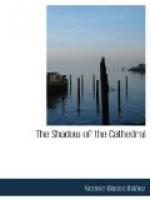joyful, popular—democratic as you would
say, Gabriel; there was no Inquisition, nor suspicion
of heresy to embitter the soul with fanaticism and
fear. All the coarse wind and stringed instruments
that the artisans had in the towns, or the labourers
in the fields, came into the churches, and the organ
was accompanied by violas, violins, bagpipes, flutes,
guitars and lutes. The plain song was the established
liturgy almost throughout Europe; but the people disliked
it, and interspersed it with songs, and at the great
festivals, religious hymns were sung, adapted to the
popular melodies then in fashion, such as ‘The
song of the armed man,’ ’Morencia, give
me a kiss,’ ‘I know not what confuses
me,’ ‘Weep for me, lady,’ ’Bad
luck to him who married you,’ and others in
the same style. And Rome, you will ask, and the
Church? What did it say about such disorders?
The Church lived without artistic perception:
it never had any. What are the boundaries between
religious and profane music? From the sixteenth
to the seventeenth century all critics have asked themselves
this question, but the Church let them talk, accepting
everything without remark. Now and again Rome
made itself heard by a Papal bull, to which no one
paid any attention, because the Pontiff was incapable
of saying this is religious art, and the other is
profane. Palestrina was entrusted with the task
of reforming church music; the Pope showed himself
disposed not to leave anything but plain song, and
to suppress even that if necessary. The mass
of Papa Marcelo and other melodies was the result
of this, but things did not advance much. It was
necessary in order that music should be purified inside
the Church that the great secular musical movement
should begin with the Italian Monteverde, with the
Frenchman Rameau, and with the Germans Sebastian Bach
and Handel; what splendid times, Gabriel! And
just think what genius followed: Gluck, Haydn,
Mozart, Mehuel, Boieldieu, and, above all, our good
friend Beethoven.”
[Footnote 1: The stave.]
The Chapel-master was silent for a little as though
the name of his idol imposed on him a religious silence.
Presently he continued.
“All this avalanche of art passed over the Church,
and she, according to her habit, appropriated everything
that was most to her taste; in any country the Catholic
religion adopted the music most in accordance with
its traditions—in Spain we have been saturated
with the Italian style since the days of Palestrina,
and German or French music never came to us.
We were first of all fuguists and contrapuntists; but
after the ‘Stabat Mater’ of Rossini we
felt the attraction of theatrical melody so strongly
that we have never wished to taste a fresh dish.
Religious music in Spain has run parallel with Italian
opera, a thing of which the canons are ignorant; they
would be furious if at the mass you played them anything
by Beethoven, which they would consider profane, but
they listen with mystic unction to fragments which




